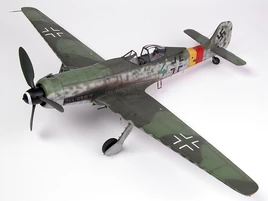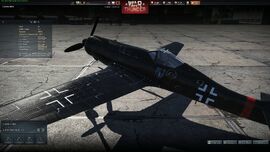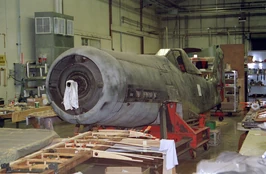Focke-Wulf Ta 152[]
The Focke-Wulf Ta 152 was a World War II German high-altitude fighter-interceptor designed by Kurt Tank and produced by Focke
-Wulf. The Ta 152 was a development of the Focke-Wulf Fw 190 aircraft. It was intended to be made in at least three versions—the Ta 152H Höhenjäger ("high-altitude fighter"), the Ta 152C designed for medium-altitude operations and ground-attack using a different engine and smaller wing, and the Ta 152E fighter-reconnaissance aircraft with the engine of the H model and the wing of the C model.

Ta-152
The first Ta 152H entered service with the Luftwaffe in January 1945. While total production—including prototypes and pre-production aircraft—has been incorrectly estimated in one source at approximately 220 units, only some 43 production aircraft were ever delivered before the end of the European conflict.
These were too few to allow the Ta 152 to make a significant impact on the air war.
Design for high altitude performance[]
To reach higher altitudes, a pressurized cockpit was added to the H models. The canopy was sealed via a circular tube filled with rubber foam which was inflated by a compressed air bottle, while the engine compartment was also sealed from the cockpit with a rubber foam ring. A Knorr 300/10 air compressor provided the pressure, maintaining the cockpit at .36 atmospheres (5.29 psi) above 8,000 m (26,250 ft). To prevent fogging, the windscreen was of a double pane style with a 6 mm (.32 in) thick outer pane and a 3 mm (.118 in) inner pane with a 6 mm (.24 in) gap. The gap was fitted with several silica gel capsules to absorb any moisture forming between the panes.

Ta-152-1
The aircraft had an increased wingspan compared to the previous Fw 190 design, as a further accommodation towards better high altitude performance. Due to the war's impact onaluminum availability, the wing was built around two steel spars, the front extending from just past the landing gear attachment points, and the rear spar spanning the entire wing. The wing itself was designed with 3° of washout, from the root to the flap-aileron junction, to prevent the ailerons from stalling before the center section of the wing. This design allowed the pilot to maintain roll control during a stall and extreme flight envelope maneuvers.
The Ta 152H boasted excellent high altitude performance, using a Jumo 213E engine (a high-altitude version of the Jumo 213A/C used in the Fw 190D), a two-stage, three-speedsupercharger and the MW 50 methanol-water mixture engine boost system.
In Combat[]
An early Ta 152 combat occurred on 14 April 1945 when Oberfeldwebel Willi Reschke tried to intercept a De Havilland Mosquito over Stendal, but failed to catch up due to engine trouble.

Ta-152 Thunder War
On the evening of that same day, Reschke was to demonstrate that the Ta 152H could be used as a low altitude fighter. A section of four Hawker Tempest Vs of 486 (NZ) Squadron were out on patrol. After attacking a train near Ludwigslust, the section split up into pairs; Wing Commander Brooker ordered the Tempests flown by Flying Officer S. J. Short and Warrant Officer Owen J. Mitchell to make their own way back to base. On the way back, this pair, which was strafing targets along the railway tracks near Ludwigslust, was spotted by lookouts posted at Neustadt-Glewe. Three Ta 152s—flown by Reschke, Oberstleutnant Aufhammer and Oberfeldwebel Sepp Sattler—were scrambled, catching the Tempests by surprise. Reschke declared:
We reached the position at an altitude of 200 metres, just at the moment when both Tempests after diving started climbing again. Just as the dogfight was developingSepp Sattler, on our side, was hit and his plane fell like a stone out of the sky ... The Tempest which I attacked quickly reached the same height as me and was [at] approximately 10 o'clock before me. The dogfight began between 50 and 100 metres above ground level and very often the wing tips passed close over the treetops ... The whole fight was executed in a left-hand turn, the low altitude of which would not allow for any mistakes. Ever so gradually I gained metre-by-metre on the Tempest and after a few circles, I had reached the most favourable shooting position ... I pressed my machine gun buttons[10] for the first time ... I could see the Tempest for a short moment in straight ahead flight displaying slightly erratic flying behaviour. But immediately she went straight back into the left turn ... I sighted the Tempest very favourably in my cross hairs and could not have missed, but my machine guns experienced feeding problems. I therefore tried to shoot it down with my cannon and forced her into a tight left-hand turn from where she tipped out over her right wing and crashed into a forest.

Ta-152 Survivor
(A more detailed and slightly different account of this incident, also by Reschke, is given in 'Fw190 Aces on the Attack' published by Osprey)
Variants[]
- Ta 152 H-1
- The only production version.
- Long wing, armed with one engine-mounted Motorkanone 30 mm (1.18 in) MK108 cannon and two 20 mm synchronized MG 151/20 cannons in the wing roots, additional fuel tanks located in the wings.
Specifications (Ta 152 H-1)[]
General characteristics
- Crew: One
- Length: 10.82 m (35 ft 5 63/64 in)
- Wingspan: 14.44 m (47 ft 4 1/2 in)
- Height: 3,36 m (13 ft 1in)
- Wing area: 23.5 m² (253 ft²)
- Empty weight: 4,031 kg (8,640 lb)
- Loaded weight: 4,727 kg (10,470 lb)
- Max. takeoff weight: 5,217 kg (11,501 lbs)
- Powerplant: 1 × Jumo 213E liquid-cooled inverted V-12, 1,287 kW (1,750 PS; 2,050 PS with MW-50)
Performance
- Maximum speed: 759 km/h at 12,500 m using GM-1 boost (472 mph at 41,000 ft using GM-1 boost)
- Range: 2,000 km (1,240 mi)
- Service ceiling: 15,100 m using GM-1 boost (49,540 ft using GM-1 boost)
- Rate of climb: 20 m/s to 25.4 m/s (3,937 ft/min at maximum weight of 5,217 kg to ~5,000+ ft/min at 4,727 kg)
- Wing loading: 196.8 kg/m² (41.38 lb/ft²)
- Power/mass: 0.276 kW/kg (0.167 hp/lb)
Armament
- 1 × 30 mm MK 108 cannon
- 2 × 20 mm MG 151/20 cannons